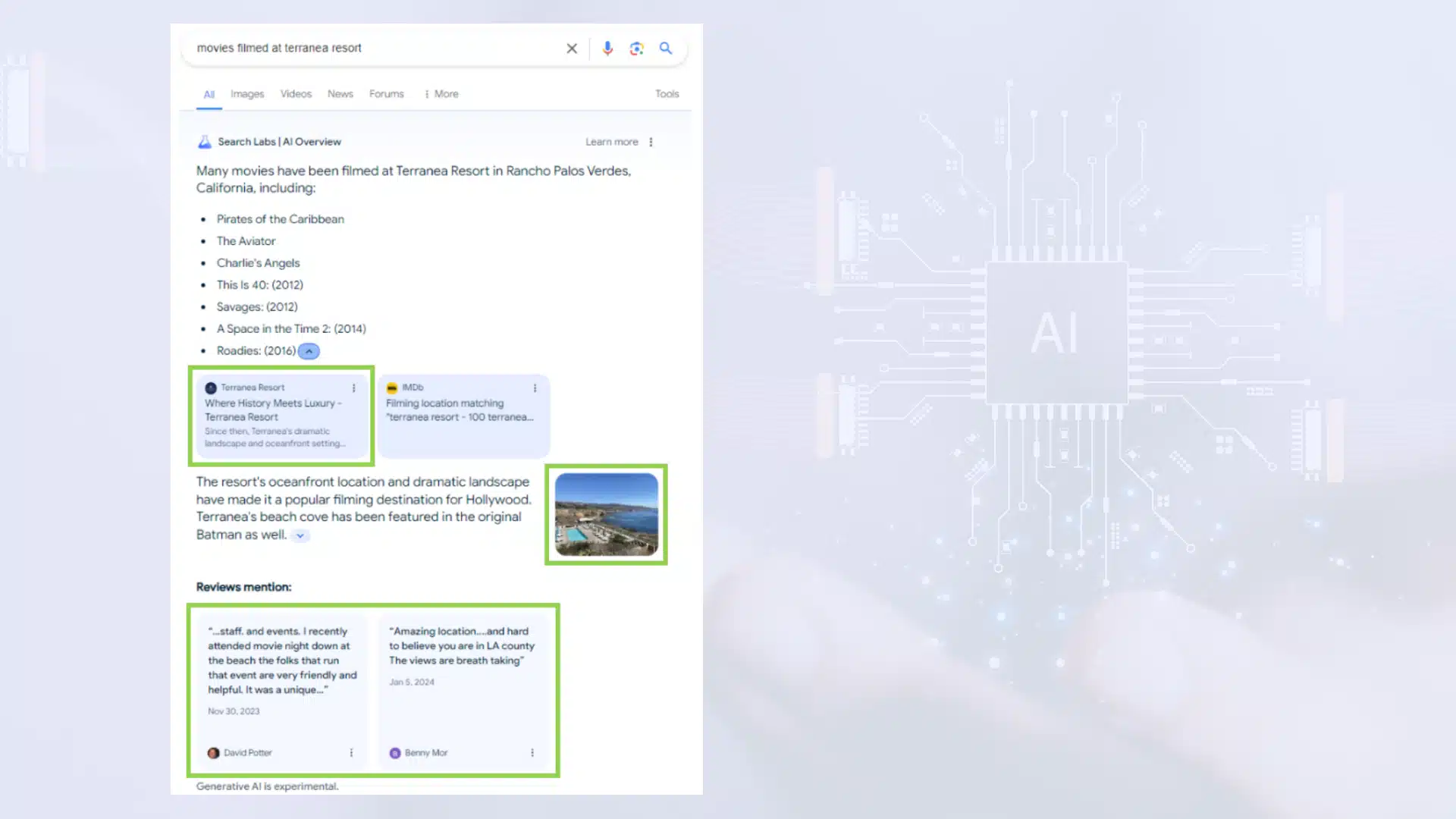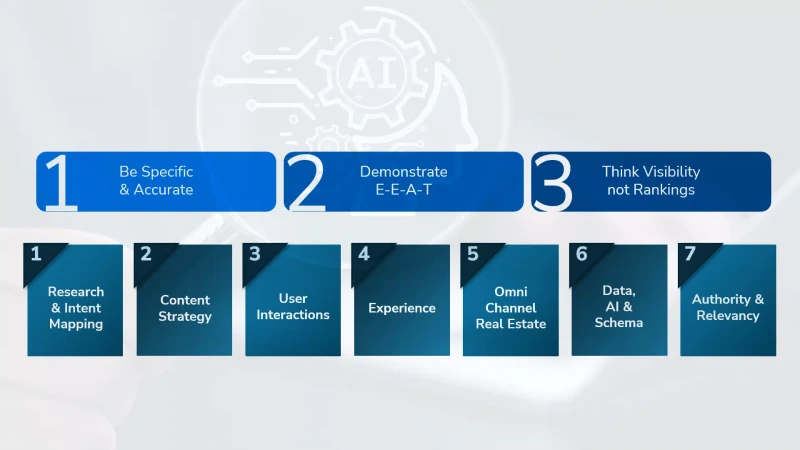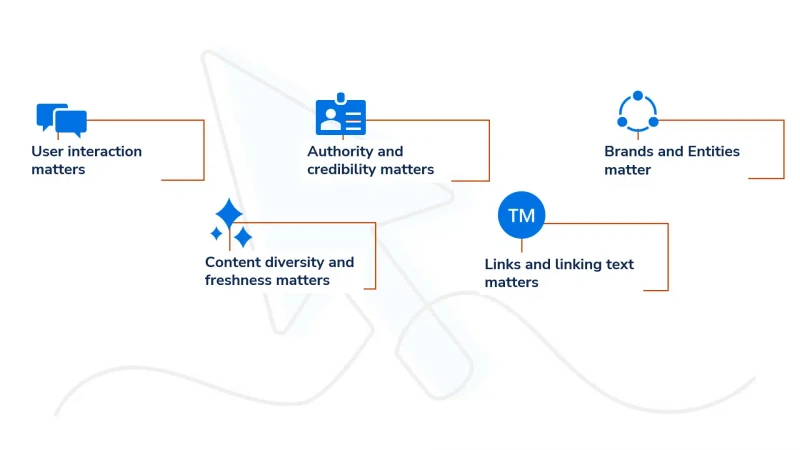7 strategies to maximize your AI-powered search market share
In this new age of AI-driven search, it’s essential to move away from siloed marketing strategies and realign to future-proof your position in the SERP.
This article outlines seven key focus areas for maximizing your brand’s presence in AI-driven search.
The evolving AI-powered search landscape and the rise of zero-click results
Up to 59% of Google searches end without a click, with nearly 30% of clicks getting directed toward Google-owned assets like images, videos and social profiles, according to a recent study by SparkToro’s Rand Fishkin.
This makes it critical for brands to saturate the SERPs and prioritize showing up for zero-click results.
AI Overviews and content diversity
With AI Overviews, Google can now generate a concise and helpful summary for any query that offers relevant insights, a user-friendly experience and authoritative links that allow users to dive deeper.

These overviews are mainly displayed for informational and long-tail queries and, on average, contain around 7.2 links.
They surface a variety of content types, including images, videos and PDFs, making it critical to diversify your content and implement strategies like image optimization.
The impact of AI-powered search on website traffic
Typically, we can expect to see a 30% to 40% decline in traffic coming to websites, depending on the vertical, due to AI Overviews and zero-click rich results.
While these results reference similar sources and domains used for rich snippets and organic results, they work on a fundamentally different underlying system.
AI-powered search pulls the most relevant information across all channels and assets, using a variety of LLMs, schema/structure data, freshness and user click data to display these results.
Embracing zero-click trends and content diversity to saturate SERPs is key to success in this new landscape.
7 focus areas for maximizing your share in AI search

If you want to future-proof your digital presence, you’ll need to focus on delivering valuable information and experiences that truly connect with users while creating content that meets their specific needs and intentions.
Here are the top strategies for winning in the era of AI.
1. Research and intent mapping
The first step is understanding what appears in AI Overviews. AI-powered search algorithms are constantly evolving to provide the most relevant and high-quality results.
While large language models are useful, they can contain outdated information. Tools such as Semrush and Ziptie can help identify queries that trigger AI overviews for your business, competitors or industry.
By compiling a comprehensive list of topics, intents, domains, citations, sources, content assets and competitor domains, you can craft a thorough search strategy.
2. Content strategy
Creating a robust intent-driven content strategy is essential for success. This involves:
- Creating relevant, authoritative and fresh content that covers the entire marketing funnel.
- Assessing content decay.
- Using metrics to develop a data-driven, omnichannel content strategy.
Ensuring the discovery, relevancy and visibility of your content is crucial to futureproofing it for AI-powered search.

Diversity and topicality
Content should be topical, demonstrate a high level of E-E-A-T and provide the most relevant responses to queries.
To deliver well-rounded responses, use a combination of images, videos, PDFs and well-designed layouts.
Don’t forget to adopt a topical entity-first strategy. Google’s “site focus score” also reflects how consistently a site maintains its core focus, with topical authority typically enhancing overall search visibility.
Authority and freshness
The importance of authorship and subject matter expertise is growing.
AI-generated responses are dynamic and contextual, changing based on the query intent and previous interactions to select the most relevant sources.
Google utilizes various LLMs to discern the intent of queries. However, these LLMs can sometimes provide outdated or irrelevant information, which underscores why search engines prioritize the freshness of content.
This emphasis on recency includes a variety of attributes like byline dates and semantic freshness. Google particularly relies on these date indicators to assess the currentness and accuracy of content.
Cover the full funnel
Top-of-funnel searches will eventually be dominated by some form of generative AI, whether from Google or another provider, according to Eli Schwartz.
To navigate this shift, marketers should concentrate on the mid-funnel stages of searches. It’s also key for marketers to address every stage of the buyer’s journey, from social media to paid advertising to brand interactions.
Both organic and paid searches are integral components of the buyer’s journey, but they are neither the sole focus nor the final goal.
Optimizing strategies around the buyer, rather than just the search results, ensures that the right KPIs are integrated into your marketing efforts.
Employing a comprehensive funnel strategy that addresses all touchpoints of the buyer’s journey is essential to maximize market share.
Focus on the right metrics
Are the right KPIs being used to measure the impact of your content? Issues like content decay are prevalent in AI-generated search results.
Producing purposeful, high-quality content drives essential KPIs such as impression share, SERP saturation and CTR, making it critical to focus on the KPIs that align with your goal, whether it’s driving visibility, engagement or conversion.

Passage-based ranking: Hidden gems
Google aims to provide the best answers to user queries, whether from a forum comment, an article snippet or an FAQ passage, according to Conductor’s Patrick Reinhart.
Passing ranking and citation links in AI Overviews guide users directly to specific, highlighted parts of webpages.
The AI Overview image for Terranea above shows how specific information about movies that were filmed shows up.
For brands and marketers, it’s crucial to share valuable context to benefit from hidden gems in ranking passages.
Brands must respond effectively to queries like “Do Nike shoes run small?” according to Bill Hunt.
Today, responses to questions like these will most likely come from forums.
3. User interactions and click data
Google constantly learns from how users interact with search results and the data from their clicks to better prioritize its rankings. User task completion is a critical metric in this process.
The recent Google data leak indicated use of clicks, links, content, entities and Chrome clickstream data to refine its ranking algorithms.
Google’s Navboost ranking signal sorts clicks into categories, including good clicks, bad clicks and click intervals. These interactions and click signals help determine if the right results are being shown.

Using click data as a performance metric supports AI algorithms and helps improve site effectiveness.
When we develop content that is rich in topics and entities, diversify it and link these pages deeply with similar topics, providing contextual information, user-level metrics can improve significantly.
4. Experience
User experience matters. Strategies like personalization, A/B testing, heatmaps, and CRO play a huge role in future-proofing your digital experience.
The future of search is multimodal, so it’s essential that your images, text, PDFs and videos are discoverable and relevant.
Your platform, site architecture and tech infrastructure are key to ensuring your content is crawlable, available and indexable.
To keep your site running smoothly, it’s important to ensure it’s lightweight and performance-optimized.
Hosting scripts and heavy assets on a separate CDN can help speed things up while also ensuring compliance with all GDPR, security, privacy and ADA regulations.
5. Saturate SERPs and real estate
It’s important to think holistically about the SERP.
Your brand’s goal should be to saturate all channels and every type of SERP, whether that’s through paid ads, organic results, social media, knowledge graphs, rich snippets, images, videos or AI Overviews.
Look at how your brand and non-brand content appear across various LLMs for branded and non-branded topical searches.
Paid results often appear alongside AI Overviews for similar queries, which has really changed the dynamics of both the paid and social funnels.
6. Data quality, AI search and schema markup
For AI search to really work its magic, maintaining high-quality data is key. Your data, knowledge graph and schema markup play a big role in prepping for AI-driven search.
Ideally, you should update your schema markup as soon as your content changes, monitor any schema errors or warnings and regularly update your schema vocabulary.
This can be a bit tricky, especially for large websites, but it’s crucial to avoid any long-term schema drift or errors.
Keeping everything tight and accurate helps ensure that AI tools can understand and effectively use your data.
7. Authority and relevancy
Authority and relevancy are important when it comes to sources that show up in AI-powered searches.
Want to boost your brand’s visibility in search engines? Grow your authority.
Things like sprucing up your local listings and experience, getting active with digital PR and engaging in community events can really help improve your authority.
This kind of proactive engagement ensures your brand stands out in the crowded digital landscape.
Mastering AI-powered search for maximum brand visibility
Navigating the complexities of AI-powered search requires a multifaceted approach that bridges silos across organizations and channels. Hunt said:
- “Total search is only possible when companies and brands focus on findability, not channels or departments, prioritize consumer interest and intent, create diverse content strategies and ensure data is discoverable and relevant.”
As search continues to evolve with advancements in AI, maintaining a dynamic, flexible strategy will be key to outperforming competitors and captivating your audience at every stage of their journey.
Armed with these top strategies, your brand is well-prepared to thrive in the era of AI-driven search, maximizing market share and delivering exceptional user experiences.